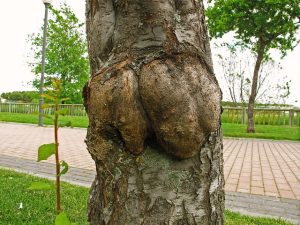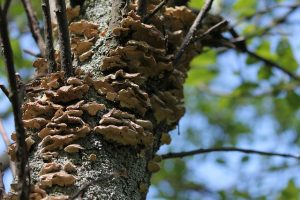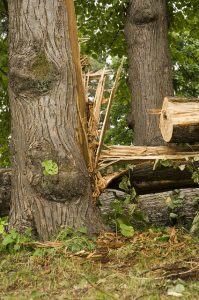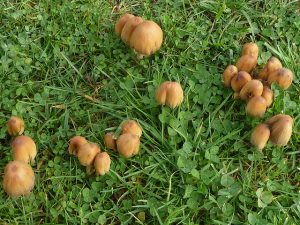“There’s a fungus among us” might be one of your favorite party jokes, but it isn’t something you want to joke about when it comes to your Southern CA yard. Most of us don’t pay attention to our trees all that much, unless something goes wrong. However, tree fungi is a sign that something may be going seriously wrong inside your tree, or it can start outside of your tree and cause something to go wrong on the inside. If you don’t treat tree fungi, the tree will eventually succumb to either a problem related to the fungus or something that is able to take hold because of the weakened tree.
Fungi is such a problem because it can cut off the flow of water and nutrients and invite pests and other diseases into the tree. Even if your tree appears healthy, it can still be a huge problem.
While all tree care professionals can spot tree fungus quite easily, most homeowners don’t think to know the signs and symptoms of tree fungi. This is something one needs to know, however, if you want to keep your home and family safe. If you live in Southern California, these are some warning signs of tree fungi:
4. Yard Moisture
- Moisture Monitors Available
- Avoid Watering Infected Plants
- Beware of Rain Runoff
One of the most important things to understand about your yard is the level of moisture in the air. If you have a pool, a pond, or live by the water, the moisture levels in your yard are going to be higher. This could mean that you have an increased chance of fungal diseases on your trees and plants. In California, since there isn’t as much moisture in the air, anywhere moisture lingers is a target area for fungi.
According to Planet Natural, “During the summer months, especially if plants are watered by overhead sprinklers, sufficient moisture may be present for infection when the bacteria are splashed or blown on to leaves.” This means you do have to be careful if you suspect that your trees or plants have a fungal problem. It is quite easy to spread the disease simply the taking care of your yard.
3. Beware Soft Spots
- Touch Wounds Carefully
- Wash Hands Between Trees
- Use Finger Tips
If there is something soft on the bark of your trees, or if the bark itself is soft, it is a sign that there is a big problem. Use your fingertips to go over the bark of the tree, gently applying pressure to find any signs of damage or issues. As you are supposed to check your trees at least twice a year for problems, take a few extra minutes to just touch your tree.
Make sure to look for areas that appear darker or discolored from the rest of the tree. See if that area is soft. Michigan State University hastens to warn people that soft bark isn’t always an issue, in fact, some trees are softer than others. However, it is a common problem that you will find with some trees in California.
Remember to be gentle and never use your fingernails to puncture the tree, or you will just be doing more damage than good.
2. Check Wounds
- Beware of Soft Spots Near Wounds
- Check Discoloration or Any Growths
- Canker Diseases Can Be Found in Wounds
Just like in humans, the rate at which our trees heal themselves and their wounds is a sign of how healthy they are. Make sure to look around the wounds that develop on your tree as they grow. All wounds need to be checked, including those that come from cutting, breaking, animal damage, and infestations. According to the University of Kentucky, wood decay fungi are common in wounds.
There are quite a few different types of fungi out there and they don’t all have a lot in common. However, they all go after the weakest spots on the tree, which tends to be where our trees have been wounded. They are able to quickly infiltrate the tree here, sucking up the nutrients and water. Tree fungi move faster here, and it is likely that it will become a bigger problem much more quickly than if you don’t have wounds.
1. Mushrooms
- Biggest Sign of Tree Fungi
- Requires Action ASAP
- Do Not Remove
Mushrooms are a huge sign that there is something going on with your Southern CA yard and tree. While most people think about mushrooms and don’t believe they are a problem, they are actually a fungus. It shows that there is something in the chemistry of your yard. While mushrooms aren’t always a sign that something is going wrong with your trees, they are something you want to get checked. One or two mushrooms may not be a problem, but note that the mushrooms don’t have to even be on your tree to be a symbol of problems in the root system.
Mushrooms almost always symbolize something, according to Fine Gardening, so if you see them, make sure to investigate your trees even further.
Tree fungus doesn’t always mean that there is a huge problem with your tree. However, it isn’t something that you want to ignore either. Be safe and contact a tree care professional immediately if you find any of the above problems on your trees. Most professionals will be able to solve the issue without eliminating your tree. However, if the fungal infection is too far along, then there may be a need to remove the tree so that it doesn’t spread to other plant life.
At Econo Tree Service, our team aims to prevent fungi and enable your trees to grow happily and healthily. We try to eliminate fungus if it is present, and we will then show you methods to keep the amount of fungus in your yard down. Our team is prepared to handle many different types of tree diseases, including fungus. Still, even the best teams are more effective when they are given the appropriate time – so give us a call today at (650) 200-2495.





